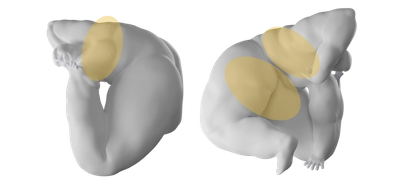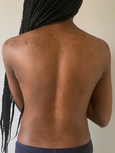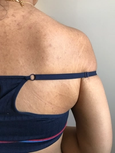Body Acne
baa · dee -ak · neeLike acne on the face. Breakouts in areas with high concentrations of oil glands, like the back, chest, and butt.
Also Called
Bacne, blackheads, pimples, pustules, “ass”-ne
Frequently Found On
Back, chest, butt

What is body acne?
Body acne is exactly what it sounds like: Breakouts on areas of the body that aren’t the face. It usually shows up on areas of the skin that have higher concentrations of oil glands than others, especially the back, chest, and arms. It is estimated that 50% of people with acne on the face also have acne on the back. It is much less common to have only acne on the back without your face being involved as well.
And because acne is the most common skin condition, affecting nearly 80 percent of people at some point in their lives, body acne isn’t far behind. It’s extremely common, and nothing to panic about. Mild-to-moderate body acne might only need a few over-the-counter products to get it under control, while more severe cases will require a trip to the dermatologist.
There are six different types of bacterial acne, or what most people just call breakouts, that you’ll encounter with body acne: Blackheads (a type of clogged pore, which look like little black dots on the skin), whiteheads (like blackheads, but white dots), papules (small red spots that appear under the skin), pustules (red spots—pimples—which come to a head with pus), nodules (a more intense and larger version of a papule, larger than 10 mm, which remain under the skin), and cysts (softer boils than nodules which fill with pus, and are tender and sensitive to touch).

Like any skin condition, body acne varies from person to person in how it looks and what causes it. So if all of that is starting to sound clinical and confusing, well, it can be. That’s why we recommend visiting a dermatologist if you’re trying to diagnose a mysterious new breakout on your back. It might be body acne, which is treatable and very common, or it might be a fungal infection (also common!), or it might be something more serious. Having a dermatologist check it out will give you the best guidance possible—and peace of mind.
What causes body acne?
You can get body acne anywhere there are sebaceous glands, which are all over your body, except for your palms and soles of your feet1 (your genital area can even get zits). Sebaceous glands release a fatty, oil-like substance called sebum onto the surface of the skin to lubricate and protect it.2 Acne typically develops in areas where we have the highest concentrations of oil glands, which is why it often develops on the face, chest, and back.

Excess sebum production is one cause of acne, but there are multiple. In addition to overzealous sebum production, bacteria, clogged pores, and inflammation are all common causes of body acne. Because acne is the most widespread skin condition in the world, it’s always being studied,3 and scientists are still trying to find out the many reasons why the body produces excess sebum.4
Certain behaviors or environmental stressors can pile on and help cause body breakouts too. If you don’t properly rinse off your shampoo and conditioner, the oily residue left behind can lead to back acne.5 If you tan, which dries out your skin, your body’s sebaceous glands can overcompensate, leading to chest acne. Sweaty sports bras, underwear, or yoga pants can make bacteria clingy and clog pores. Excessively moisturizing your butt (an area which naturally doesn’t need much moisture, by the way) or using too slick of a body oil can also lead to clogged pores. Studies have found that high glycemic foods, like highly processed snacks and sugar, can exacerbate acne, while the link between dairy and acne, and other dietary connections to acne,6 are possible, but in need of more research.7 And then there’s stress, which can generally increase oil production and inflammation.
The cause of body acne is going to be different for everyone, so to find out what is specifically causing yours, visit a dermatologist for a full diagnosis.
How do you treat body acne?
The solution for body acne isn’t that much different than treating facial acne, but that breakout in between your shoulder blades might be a lot harder to reach. You’ll want to take a two-prong approach to treatment to get rid of the pimples that you have and prevent new ones from popping up. Start with products that gently exfoliate the skin as prevention. Retinol, which unclogs pores, can be used for this, along with products containing lactic or glycolic acids. These chemical exfoliants—usually sold as liquid body lotions or toners—dissolve dead skin cells that might be mixing with sebum and bacteria, leading to acne.
Retinoids are the “core of topical therapy for acne,” according to the American Academy of Dermatologists.8 Several studies have shown the efficacy of retinoids on treating and preventing the growth of pimples, but their use isn’t as widespread as other topical treatments (due to an education gap—many people don’t understand how they work).9 Retinoids can also help treat acne scarring, which is especially common in black skin.10 The downside is that retinoids can be drying and make the skin sensitive to the sun, so you might not use them every day, but talk to your doctor if you have questions about retinoids and your skin.
To fight already existing acne, seek known acne-fighting ingredients like benzoyl peroxide, which is available over-the-counter. Benzoyl peroxide is an antimicrobial ingredient that kills bacteria and also helps clear out clogged pores that transform into breakouts.11 The AAD recommends benzoyl peroxide, especially gentler formulas with 5.3%, as its first choice as a topical treatment for mild cases of acne.12 But a small warning: If you use any products with benzoyl peroxide, be careful with clothing and fabrics, which you might accidentally tie-dye. While effective, it can bleach darkly colored fabrics, including sheets, undergarments, and shirts. It's best to use white fabrics or sticking to fabrics that are old and you don’t care about. Another warning: Higher percentages of benzoyl peroxide, like 10%, can really dry the skin out to the point of peeling.
Topical acne creams sink into the skin and get to work, while body washes are another, gentler option good for sensitive skin. Cleansers are useful when treating back acne because they can be used in the shower, can cover large body surface areas, and can treat otherwise difficult to reach areas.
Salicylic acid cleansers are the most common acne treatment ingredient in body washes and body scrubs (Neutrogena's Body Clear Body Wash is a popular one), which you can get over the counter at any drugstore or supermarket. Salicylic acid is an oil-soluble beta hydroxy acid that can penetrate deeper into the skin to unclog pores, remove oil from the skin, and dry out pimples.13 It’s in acne-fighting face washes too, so you could use the same cleanser you use on your face on your body.
You can also treat breakouts with sulfur, which is antibacterial (like benzoyl peroxide) and keratolytic, meaning it helps clear away dead skin and keep pores from clogging, and is often combined with other ingredients so it doesn’t dry out the skin too much.14
Though slightly less common, you can find lactic and glycolic body washes as well—look for concentrations between 5-10%. Make sure that when you’re showering with a body acne cleanser, you let it linger. Try applying a cleanser to the skin and letting it sit and lather while you sing the alphabet before rinsing it off. This allows the active ingredient time to penetrate into the follicles and do its job.
Zinc-PCA (pyrrolidone carboxylic acid), also called zinc salts, is another acne-fighting ingredient that’s both antibacterial and anti-inflammatory. Studies have found it effective in treating acne when it’s combined with other ingredients,15 and it has fewer side effects than other treatments;16 where many acne products can be drying on the skin, zinc-PCA helps hydrate the skin.17
Then there’s the complication of combining products with acne-fighting ingredients with the other exfoliators. Using too many at once might trigger dry skin conditions, causing peeling and even more redness. Talk to a dermatologist to dial in the best treatment plan for your skin (you might use retinoids at night, benzoyl peroxide during the day, to keep the skin in balance.) Over-the-counter acne treatments can help in mild or moderate cases of acne, but more severe cases, like painful cystic acne, usually require prescription treatments. Acne treatment is a $3 billion industry for a reason—there isn’t a single solution that works for everyone.18
Mass Index Recommends:

Soft Services
Clearing Clay
$28
8 oz
maximum strength
Medicated to gently exfoliate dead skin cells, allowing anti-acne, anti-breakout, anti-discoloration, and soothing ingredients to penetrate, which clear skin of bacteria and prevent new breakouts from forming.

Sanitas
Skincare Active Body Wash
$28
8 fl oz
daily body wash
A body acne- fighting body wash with glycolic acid, a chemical exfoliant that clears clogged pores of acne-causing oil and bacteria without scratching or irritating the skin like a physical exfoliant would.

Soft Services
Clearing Mist
$26
4 fl oz
acne treatment
Clinically formulated with salicylic acid to treat body acne that pops up when we work out, or otherwise get sweaty, trapping bacteria and fungus against our skin.

Dr. Dennis Gross
DRx SpectraLite™ BodyWare Pro
$435
light-therapy device
A rechargeable light therapy device that uses red and blue light to treat body acne, signs of aging, and aches in 3-minute sessions—blue light specifically targets body acne-causing bacteria.
Soft Services works with experts to review the accuracy of our content, but they do not endorse the products we made.
How do you prevent body acne?
Many of the ingredients in skincare products used to treat body acne will also help prevent it—like retinoids, benzoyl peroxide, and salicylic acid. Retinols are comedolytic, which means they clear out pores to keep them from getting clogged and turning into breakouts.19 Benzoyl peroxide directly targets the bacteria causing pimples and is pretty powerful, so it might be used less often as a preventative treatment—or just used as a spot treatment for new blemishes—while salicylic acid is gentler, and often found in cleansers safe to use daily. The American Academy of Dermatology recommends “combination therapy” (a few different treatments) to target several possible causes of acne.20 People tend to stop using acne body washes and treatments when their acne clears up, which makes sense. But using those products regularly will keep excess oil in check and keep clearing out dead skin cells and bacteria that might be clogging pores. So for anyone with oily skin or acne-prone skin, an ongoing acne-fighting skincare routine will prevent future breakouts the most.
Tweaking some lifestyle habits that might be causing body acne to flare up can help prevent body acne too. Shower immediately after a workout, or an especially hot and sweaty day, to avoid a buildup of bacteria and oil in the pores. If you can’t shower immediately, change out of sweaty clothes as soon as possible. Don’t live in tight yoga pants all day, which might be trapping bacteria in the pores. Make sure to fully rinse off shampoo and conditioner in the shower, giving the skin on your back a rinse too. Be careful not to overly tan (for many reasons—skin cancer!—not just because of acne). Beware of friction: try not to let back pack straps, purse/tote straps, or tight clothing trap sweaty skin on the shoulders and back, where body acne is common.
Citations
1,2An update on the role of the sebaceous gland in the pathogenesis of acne by Evgenia Makrantonaki et al. Dermatoendocrinol.
3Recent advances in understanding and managing acne by Ichiro Kurokawa et al. F1000Res.
4Homeostasis of the sebaceous gland and mechanisms of acne pathogenesis by R W Clayton et al. Br J Dermatol.
5Are Your Hair Care Products Causing Breakouts? by the American Academy of Dermatology Association.
6Significance of diet in treated and untreated acne vulgaris by Alicja Kucharska et al. Postepy Dermatol Alergol.
7Effects of Diet on Acne and Its Response to Treatment by Hilary Baldwin and Jerry Tan. Am J Clin Dermatol.
8Guidelines of care for the management of acne vulgaris by the Journal of the American Academy of Dermatology.
9,19Why Topical Retinoids Are Mainstay of Therapy for Acne by James Leyden et al. Dermatol Ther (Heidelb).
10Treating Acne in Patients With Skin of Color by Andrew F. Alexis et al. Seminars in Cutaneous Medicine and Surgery.
11,13Over-the-counter Acne Treatments by Ashley Decker, BS, MA and Emmy M. Graber, MD. J Clin Aesthet Dermatol.
12,20Acne Clinical Guideline by the American Academy of Dermatology Association.
14The use of sulfur in dermatology by Aditya K Gupta and Karyn Nicol. J Drugs Dermatol.
15Efficacy and Tolerability of Topical Nicotinamide Plus Antibacterial Adhesive Agents and Zinc-Pyrrolidone Carboxylic Acid Versus Placebo as an Adjuvant Treatment for Moderate Acne Vulgaris in Indonesia: A Multicenter, Double-blind, Randomized, Controlled Trial by Irma Bernadette S. Sitohang, MD, PhD et al. J Clin Aesthet Dermatol.
16The role of zinc in the treatment of acne: A review of the literature by Jessica Cervantes et al. Dermatol Ther.
17Pyrrolidone carboxylic acid and the skin by E J Clar and A Fourtanier. Int J Cosmet Sci.
18Estimated cost efficacy of U.S. Food and Drug Administration–approved treatments for acne by Michael Tassavor and Michael J. Payette. Dermatology Therapy.
Get Updates
There’s more to come.
Sign up to receive periodical updates on Mass Index, and to be the first to know when Soft Services launches new products. (If we don’t have any updates, we won’t email you.)























